Meiji Shrine is a Shinto shrine dedicated to Emperor Meiji and Empress Shoken, located in Tokyo's densely built-up area. Completed in 1920, the shrine was destroyed during WW2 but rebuilt shortly after. It features traditional Japanese architecture and offers a peaceful stroll through its grounds, which also host Shinto wedding ceremonies and offer great photography opportunities.
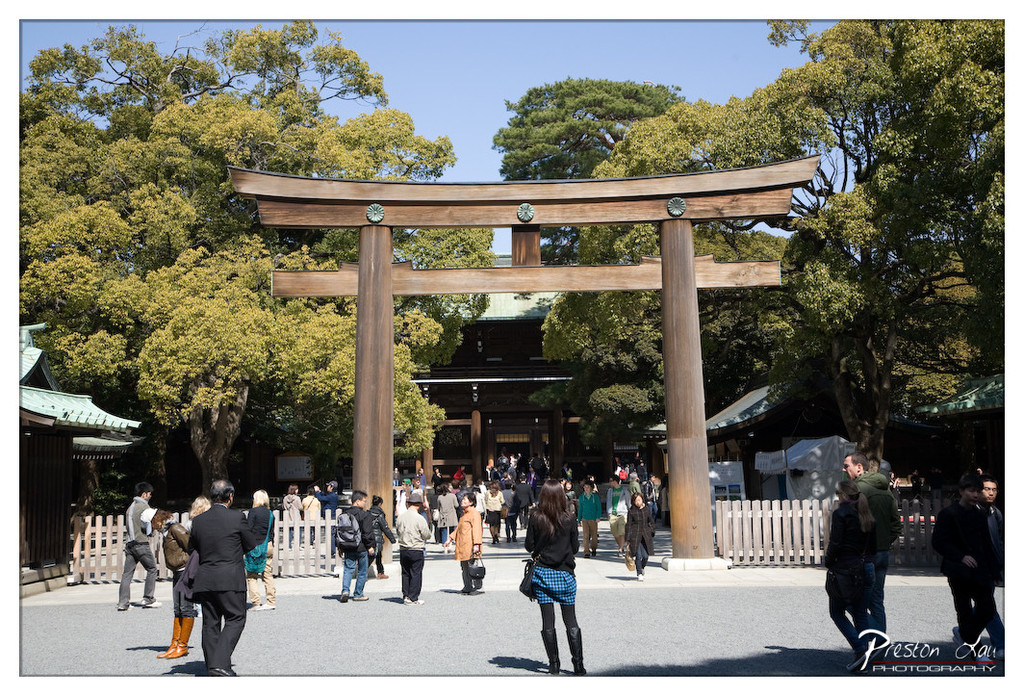

1. Overall Rating (0–10) — 7.0
This photograph captures the serene grandeur of a traditional Japanese torii gate under a clear blue sky, with visitors moving through the frame to add life and scale. The balance between cultural architecture and everyday activity creates a compelling narrative of reverence and accessibility. While the image is strong in composition and subject, a slightly more dynamic angle or tighter framing could elevate its visual impact.
2. Composition (0–10) — 7.5
The torii gate is centered and dominant, creating a strong focal point, while the surrounding trees and crowd provide natural framing and context. The low angle enhances the gate’s monumentality, though the wide perspective slightly dilutes the intimacy of the moment.
3. Lighting (0–10) — 8.0
Bright, natural daylight enhances the rich textures of the wood and the vibrant green of the foliage. The clear sky and strong sunlight create crisp shadows, adding depth and definition to the scene.
4. Color & Tone (0–10) — 7.5
The palette is harmonious, with earthy browns of the torii contrasting against the lush greens and bright blue sky. The tones are natural and balanced, though a touch more saturation could intensify the warmth and mood.
5. Creativity (0–10) — 7.0
The image successfully blends cultural documentation with a sense of place, capturing both the spiritual significance and the human presence at the site. The inclusion of people adds narrative depth, though the approach is conventional rather than experimental.
6. Technical Quality (0–10) — 8.5
Sharp focus across the frame, well-exposed highlights, and clean detail in both the foreground and background demonstrate strong technical control. The watermark is discreet and does not distract.
7. Emotional Impact (0–10) — 7.0
The photograph evokes a sense of calm reverence and cultural connection, inviting the viewer to imagine stepping through the gate into a sacred space. The presence of people grounds the image in reality, making the spiritual feel both accessible and human.
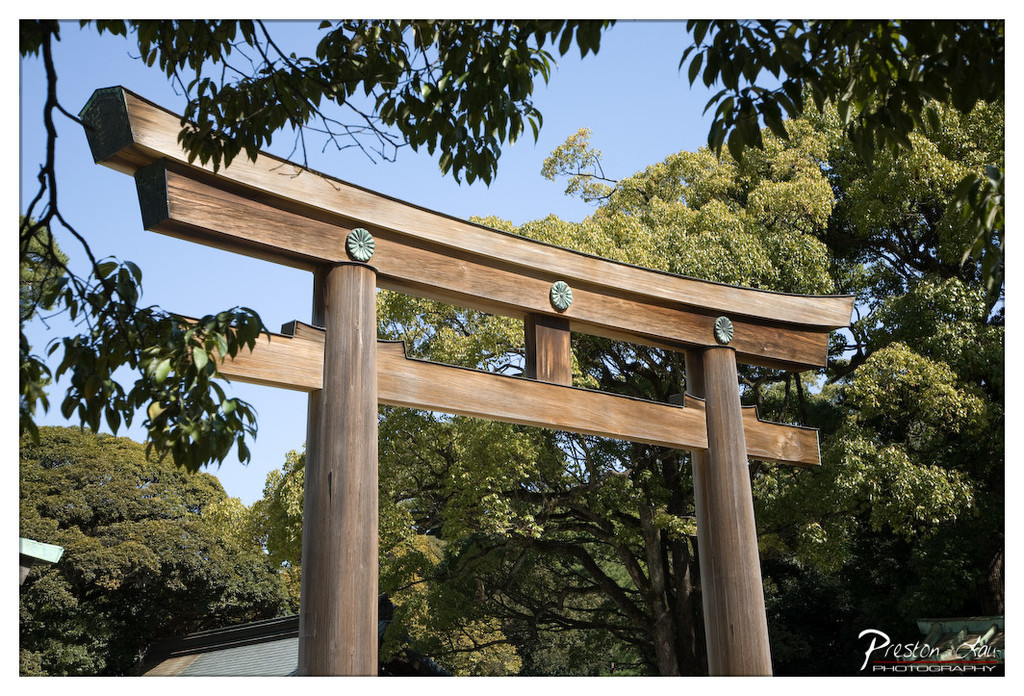

1. Overall Rating (0–10) — 7.5
This photograph captures the serene presence of a traditional Japanese torii gate, framed by lush greenery and a clear blue sky. The composition balances natural elements with cultural significance, creating a tranquil and contemplative mood. While the image is strong in atmosphere and subject matter, it could benefit from more dynamic lighting and a slightly tighter framing to enhance visual impact.
2. Composition (0–10) — 7.0
The low-angle perspective emphasizes the grandeur of the torii, while the framing by overhanging branches adds depth and a sense of enclosure. The placement of the gate is slightly off-center, creating a natural asymmetry that works well with the organic surroundings.
3. Lighting (0–10) — 7.5
Bright, natural daylight enhances the wood grain and highlights the texture of the torii. The light is even and clear, with soft shadows that add dimension without overwhelming the scene. The contrast between the sunlit wood and the shaded foliage creates visual interest.
4. Color & Tone (0–10) — 8.0
The vibrant green of the trees contrasts beautifully with the warm brown of the wooden gate and the deep blue of the sky. The color palette is rich yet harmonious, evoking a sense of peace and natural balance. The slight coolness of the sky complements the earthy tones of the wood.
5. Creativity (0–10) — 7.0
The image successfully captures a moment of cultural and natural harmony, using a familiar subject in a fresh, contemplative way. The inclusion of the photographer’s watermark adds a personal touch, though the approach remains relatively traditional.
6. Technical Quality (0–10) — 8.5
The focus is sharp across the frame, capturing fine details in the wood and foliage. The exposure is well-balanced, with no areas of blown-out highlights or crushed shadows. The image is clean and technically proficient.
7. Emotional Impact (0–10) — 8.0
There is a strong sense of calm and reverence in the photograph, inviting the viewer to pause and reflect. The connection between nature and spirituality is palpable, creating a quiet emotional resonance that lingers beyond the frame.
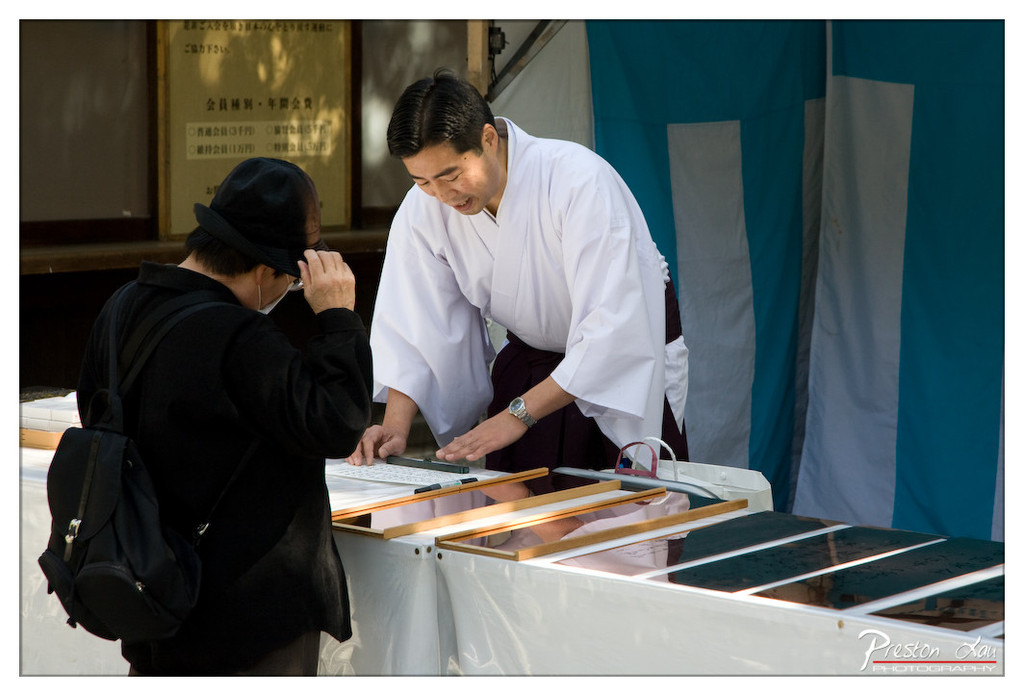

1. Overall Rating (0–10) — 7.0
This photograph captures a quiet, culturally rich moment at what appears to be a Japanese shrine or festival, where tradition meets personal ritual. The contrast between the priest’s formal white robe and the visitor’s dark, modern attire creates a compelling visual narrative of cultural continuity. While the scene is rich in context, the slightly cluttered foreground and flat lighting prevent it from achieving greater visual depth.
2. Composition (0–10) — 6.5
The subject is well-centered, but the overlapping elements—particularly the person’s backpack and the edge of the table—create visual noise. A tighter crop would enhance focus on the interaction between the priest and the visitor.
3. Lighting (0–10) — 6.0
Natural daylight provides even illumination, but it lacks direction and shadow, resulting in a somewhat flat appearance. The lack of contrast softens the scene’s emotional texture.
4. Color & Tone (0–10) — 6.5
The dominant whites and deep blacks create a stark, almost monochromatic palette, with the blue-gray curtain offering a subtle contrast. While the colors are restrained, they suit the solemn tone of the moment.
5. Creativity (0–10) — 7.0
The image tells a story of cultural exchange and reverence, capturing a real, unposed moment. The photographer’s ability to frame the ritual without disrupting it demonstrates thoughtful sensitivity.
6. Technical Quality (0–10) — 7.5
Sharp focus and clean detail are evident, particularly in the priest’s face and hands. The exposure is balanced, and the image is free of noticeable technical flaws.
7. Emotional Impact (0–10) — 6.5
The scene evokes a sense of quiet dignity and introspection, but the viewer remains slightly detached due to the distance in the composition and the absence of emotional highlights in the lighting.
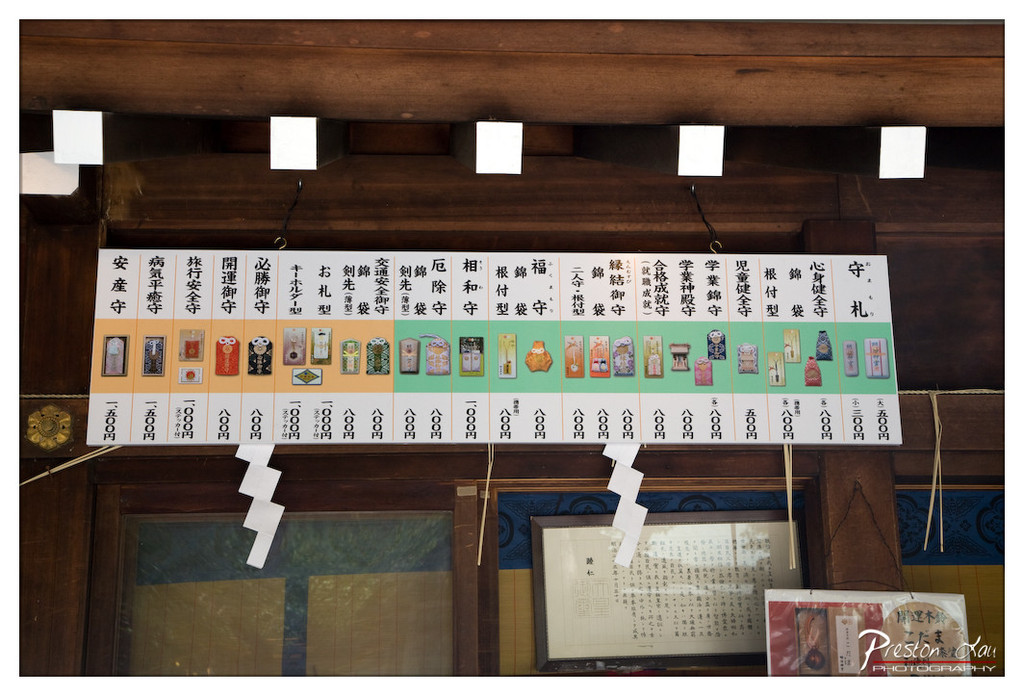

1. Overall Rating (0–10) — 6.0
This photograph captures the intricate cultural detail of a Japanese shrine’s ema board, presenting a quiet yet vibrant catalog of spiritual offerings. The composition effectively conveys the ritualistic and symbolic nature of the scene, with rows of wooden plaques representing personal prayers and wishes. While the image is rich in cultural context, the flat lighting and slightly cluttered framing prevent it from achieving a more dynamic visual impact.
2. Composition (0–10) — 6.0
The central focus on the ema board is well-placed, but the surrounding architectural elements and hanging paper strips create a sense of visual noise. A tighter crop would better emphasize the symbolic significance of the plaques and reduce distractions.
3. Lighting (0–10) — 5.5
The lighting is even and functional, capturing the details of the text and images clearly. However, it lacks depth and atmosphere, appearing more like ambient daylight than intentional illumination, which dulls the emotional resonance of the scene.
4. Color & Tone (0–10) — 5.0
The color palette is restrained, dominated by wood tones, whites, and muted pastels. While the colors are accurate, they lack vibrancy and contrast, making the image feel somewhat flat and visually subdued.
5. Creativity (0–10) — 6.5
The photograph successfully documents a cultural practice with authenticity and attention to detail. While not overtly artistic, its strength lies in its ethnographic value and the quiet storytelling of personal devotion.
6. Technical Quality (0–10) — 7.5
The image is sharp and well-focused, with clear legibility of the text and fine details on the ema plaques. The exposure is balanced, and the depth of field appropriately frames the subject.
7. Emotional Impact (0–10) — 5.5
The image evokes a sense of reverence and tradition, but the lack of dramatic lighting and emotional contrast keeps the viewer at a respectful distance. The quiet dignity of the scene is felt more intellectually than emotionally.
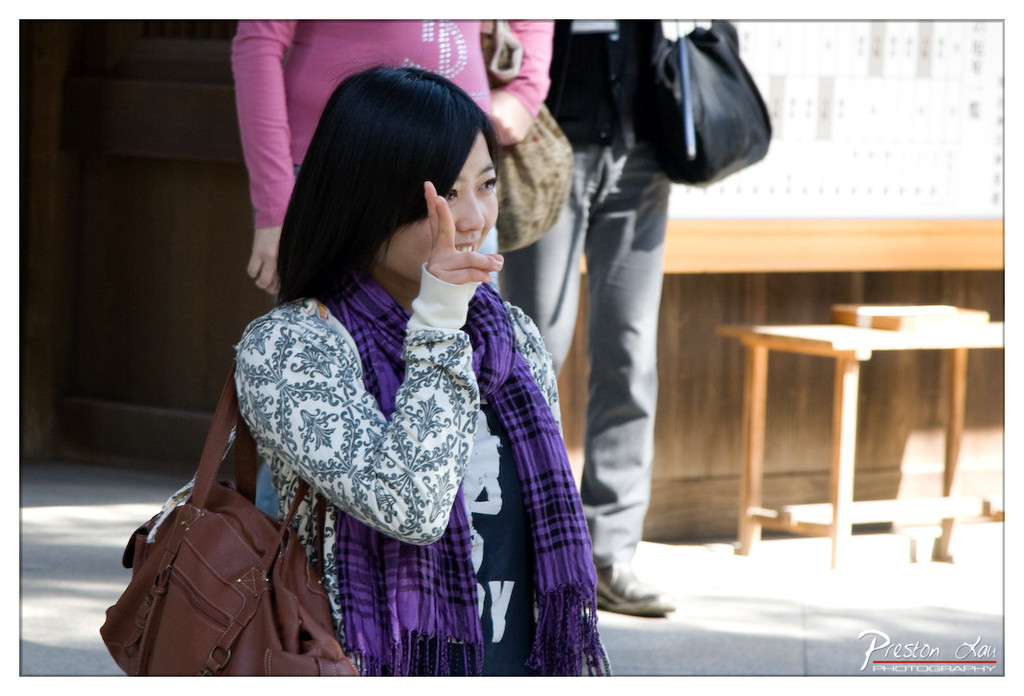

1. Overall Rating (0–10) — 7.0
This photograph captures a candid, joyful moment with a sense of warmth and spontaneity, centered on a young woman’s genuine smile and playful gesture. The natural lighting and casual composition lend the image an authentic, documentary-like quality, though the background distractions slightly undermine its visual cohesion. With stronger framing and a more deliberate focus on the subject’s expression, the emotional resonance could be even more potent.
2. Composition (0–10) — 6.0
The subject is well-placed but partially cropped, and the background figures and objects create visual clutter that competes for attention. A tighter crop and more intentional depth of field would improve focus.
3. Lighting (0–10) — 7.5
Natural daylight creates soft, even illumination with gentle shadows, enhancing the subject’s features and contributing to the image’s candid feel. The highlights on the face and scarf are well-balanced.
4. Color & Tone (0–10) — 7.0
The contrast between the purple scarf and the muted tones of the background creates visual interest, while the warm sunlight adds a pleasant glow. The color palette is harmonious but slightly subdued.
5. Creativity (0–10) — 7.5
The moment is captured with a sense of intimacy and authenticity, and the subject’s gesture adds a layer of personality. The candid nature of the shot demonstrates strong observational skill.
6. Technical Quality (0–10) — 8.0
Sharp focus on the subject’s face, clean detail in the fabric textures, and good exposure control contribute to a technically strong image, though some background elements are slightly soft.
7. Emotional Impact (0–10) — 8.0
The genuine expression and playful gesture evoke warmth and connection, inviting the viewer into a fleeting moment of happiness and lightheartedness.
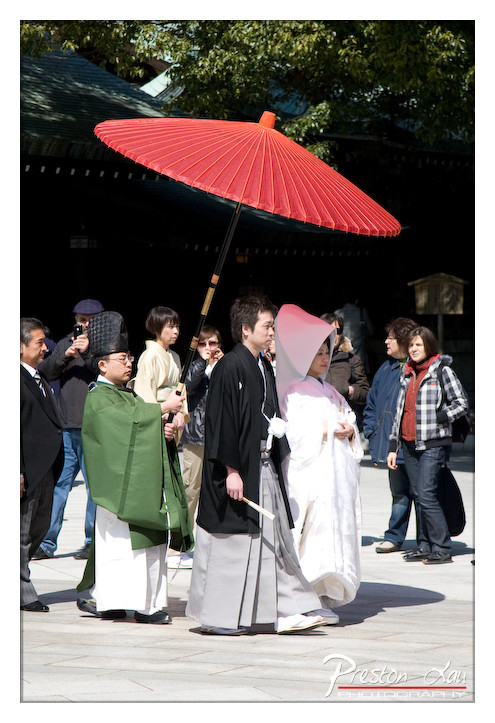

1. Overall Rating (0–10) — 7.0
This photograph captures a vibrant moment from a traditional Japanese wedding procession, where cultural heritage and modern life intersect under a bright, sunlit sky. The bold red umbrella and ceremonial attire stand out against the more casual crowd, creating a striking contrast that emphasizes the significance of the occasion. While the image is rich in cultural detail and narrative potential, the slightly cluttered background and off-center framing slightly dilute its visual impact.
2. Composition (0–10) — 6.5
The central figures are well-framed by the red umbrella, which draws the eye effectively, but the inclusion of too many background elements creates visual distraction. The diagonal movement of the procession adds dynamism, though the composition feels slightly unbalanced due to uneven spacing on either side.
3. Lighting (0–10) — 7.5
Bright, natural daylight enhances the vividness of the red umbrella and the textures of the traditional garments. The shadows are crisp and well-defined, adding depth and dimension to the scene without overexposing any key elements.
4. Color & Tone (0–10) — 7.0
The palette is striking, with the bold red of the umbrella serving as a powerful focal point against the more subdued tones of the kimono and the surrounding environment. The contrast between warm and neutral hues enhances the visual appeal, though the overall tone leans slightly cool due to the bright sunlight.
5. Creativity (0–10) — 7.5
The image successfully captures a moment of cultural authenticity and ceremonial beauty, blending tradition with the spontaneity of a public event. The choice to include onlookers adds a layer of realism, making the scene feel both intimate and communal.
6. Technical Quality (0–10) — 8.0
The photograph is sharp and well-focused, with clear details in the clothing, umbrella, and facial expressions. The exposure is well-managed, preserving highlights and shadows without significant loss of detail.
7. Emotional Impact (0–10) — 7.0
The image conveys a sense of celebration and cultural pride, evoking a feeling of joy and reverence for tradition. The presence of both participants and observers creates a shared moment of significance, inviting the viewer to reflect on the continuity of cultural practices in modern society.
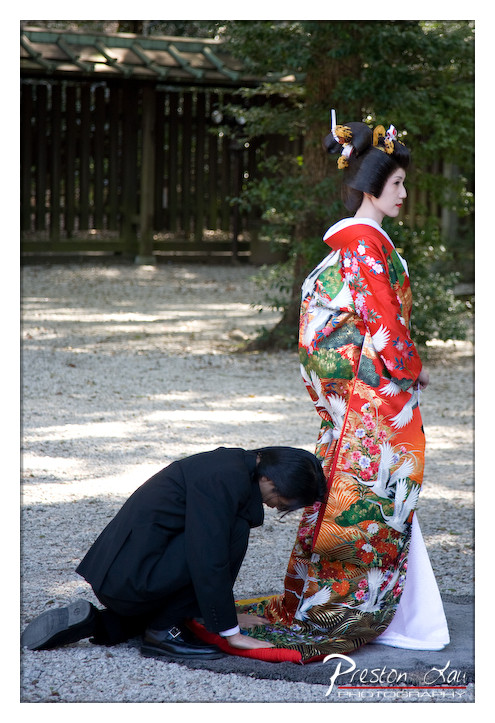

1. Overall Rating (0–10) — 7.5
This photograph captures a poignant moment of cultural reverence, where the contrast between traditional elegance and humble devotion creates a powerful narrative. The woman in the vibrant kimono, poised and serene, stands in quiet dignity as a man kneels before her in a deep bow, embodying respect and ritual. While the composition is strong and the emotional weight is clear, the slightly awkward framing and overexposed highlights temper its overall visual impact.
2. Composition (0–10) — 7.0
The subject is well-placed, with the kneeling man drawing the eye toward the woman’s regal presence. However, the tight cropping and off-center framing create a slight imbalance, and the background elements—while contextually relevant—distract from the central figures.
3. Lighting (0–10) — 6.5
Natural daylight illuminates the scene clearly, but the harsh sunlight creates blown-out highlights in the gravel and overexposed areas on the kimono, reducing detail and depth. The shadows are strong, but the lack of diffusion softens the mood.
4. Color & Tone (0–10) — 8.0
The rich, saturated reds and golds of the kimono stand out dramatically against the muted greens and grays of the setting. The color palette enhances the cultural authenticity and visual drama, though some tones appear slightly oversaturated.
5. Creativity (0–10) — 8.0
The image successfully captures a moment rich in cultural significance, blending traditional attire with a gesture of humility. The contrast between the ornate kimono and the simple black suit is striking and artistically deliberate, suggesting a story beyond the frame.
6. Technical Quality (0–10) — 7.5
Sharp focus on the subjects is maintained, and the image is clean with minimal noise. However, exposure inconsistencies—particularly in the highlights—limit the overall technical polish.
7. Emotional Impact (0–10) — 8.5
The photograph conveys deep respect, humility, and cultural pride with a quiet intensity. The posture of the man and the composed stillness of the woman evoke a sense of reverence and tradition, resonating emotionally with viewers familiar with Japanese customs.
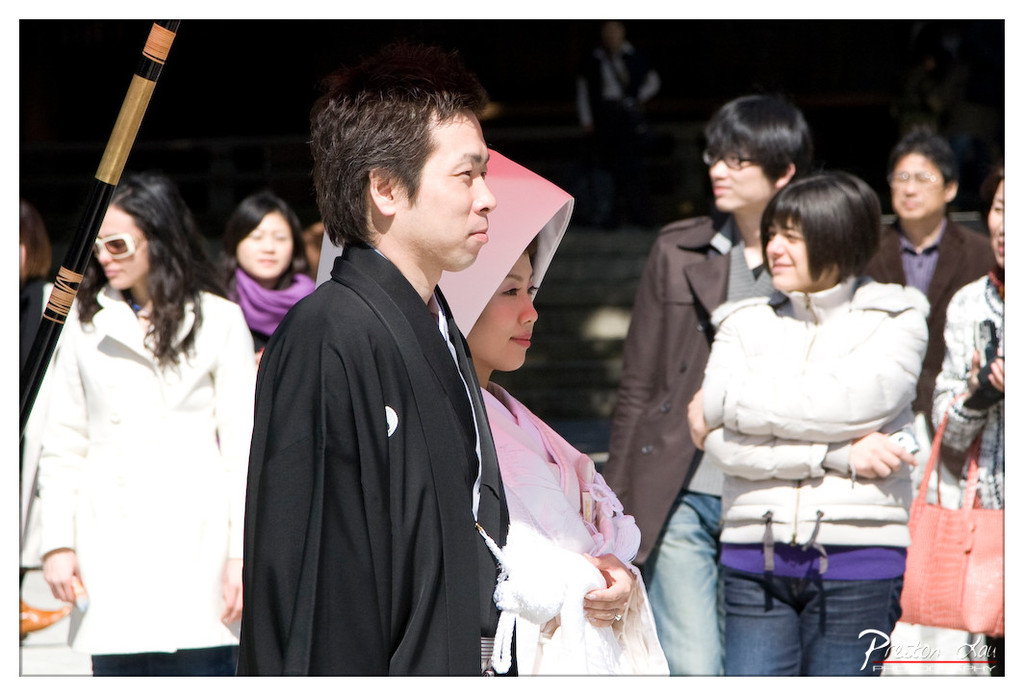

1. Overall Rating (0–10) — 7.0
This photograph captures a poignant moment at a traditional Japanese wedding, where cultural formality contrasts with the quiet intimacy of the couple. The man’s solemn expression and the woman’s gentle profile evoke a sense of reverence and shared purpose, while the surrounding crowd adds layers of context without distracting from the central subjects. Though the lighting and composition lean slightly toward the documentary, the image succeeds in conveying both ceremony and emotion with quiet dignity.
2. Composition (0–10) — 7.0
The couple is framed off-center, creating a dynamic balance with the background figures and the vertical line of the staff. The shallow depth of field isolates the subjects effectively, though the slight tilt in the frame and the crowded background introduce subtle tension.
3. Lighting (0–10) — 6.5
Natural sunlight illuminates the scene from the side, casting soft shadows and highlighting the textures of the kimono. The bright exposure creates some overexposed highlights on the white coat and background, slightly reducing tonal depth.
4. Color & Tone (0–10) — 7.5
The contrast between the black kimono, the soft pink of the bride’s obi, and the muted tones of the crowd creates a visually harmonious palette. The warm sunlight enhances the emotional resonance, though the overall color balance leans slightly cool in the shadows.
5. Creativity (0–10) — 7.0
The image captures a culturally rich moment with authenticity and sensitivity. The juxtaposition of traditional attire against a modern crowd adds narrative depth, suggesting a living tradition rather than a staged performance.
6. Technical Quality (0–10) — 8.0
Sharp focus on the couple’s faces and clear detail in the fabric textures demonstrate strong technical control. The depth of field is well-executed, and the image is free of distracting noise.
7. Emotional Impact (0–10) — 7.5
There is a quiet intensity in the couple’s expressions that invites contemplation and empathy. The image resonates emotionally by capturing a private moment within a public event, making the viewer feel like a respectful observer of a sacred occasion.
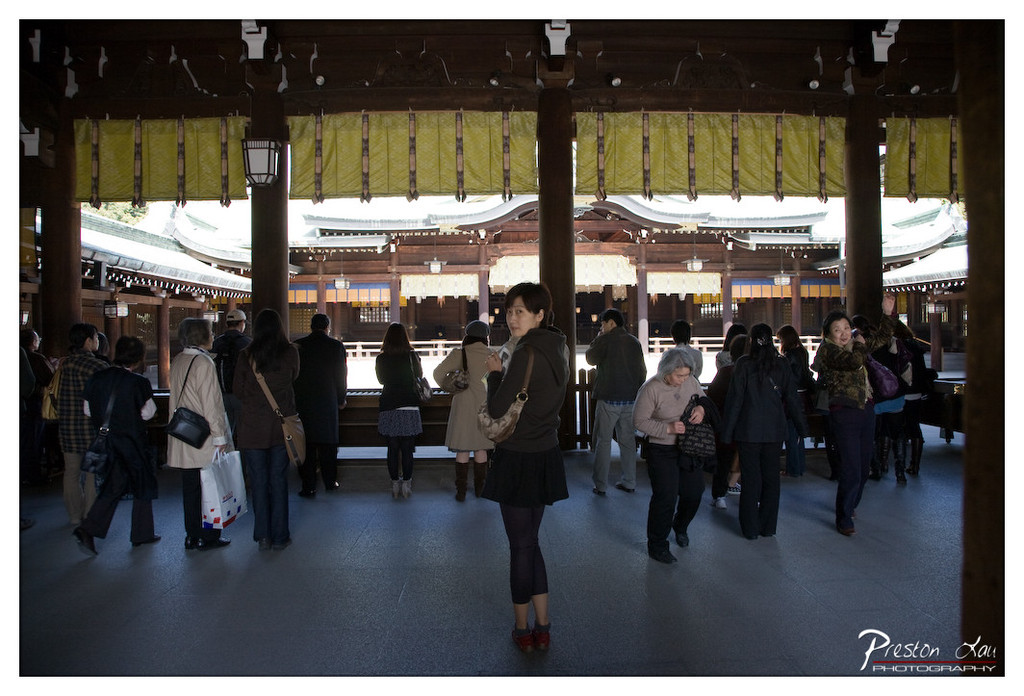

1. Overall Rating (0–10) — 7.0
This photograph captures the quiet reverence of a sacred space, where tourists and worshippers move through a temple courtyard under the weight of tradition. The deep shadows and warm highlights create a layered atmosphere, drawing the eye through the architectural elements and toward the distant shrine. While the composition feels slightly crowded and the lighting uneven, the image succeeds in conveying a sense of cultural depth and contemplative stillness.
2. Composition (0–10) — 6.5
The central figure provides a strong focal point, though the crowd’s scattered placement creates visual clutter. The framing through the dark foreground columns adds depth and a sense of viewing from within, but the lack of a clear narrative path reduces compositional clarity.
3. Lighting (0–10) — 7.0
The contrast between the dark interior and the bright exterior creates a dramatic effect, emphasizing the transition from shadow to light. The ambient light softens the scene, but some areas remain underexposed, losing detail in the shadows.
4. Color & Tone (0–10) — 6.0
The muted tones—deep browns, soft yellows, and cool grays—reflect the solemnity of the setting. While the color palette is harmonious, the lack of vibrancy gives the image a subdued, almost documentary quality.
5. Creativity (0–10) — 6.5
The use of natural framing and layered depth offers a compelling perspective, but the scene feels more observational than expressive. The photographer captures the moment without imposing a strong artistic vision.
6. Technical Quality (0–10) — 7.5
The image is sharp and well-focused, with clean detail in both the foreground and background. The exposure is generally balanced, though slight underexposure in the darker areas reduces dynamic range.
7. Emotional Impact (0–10) — 6.5
The photograph evokes a quiet sense of reverence and introspection, inviting the viewer to consider the spiritual significance of the space. The presence of people adds life, but the emotional resonance remains restrained by the image’s busy composition.
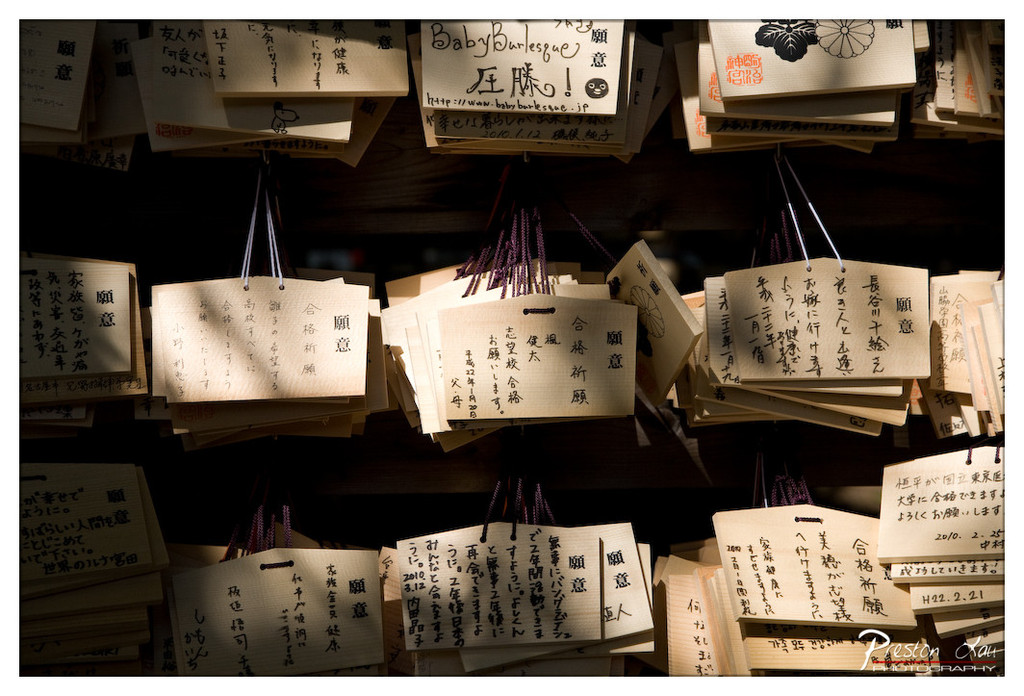

1. Overall Rating (0–10) — 7.5
This photograph captures the quiet intimacy of a Japanese shrine, where countless wooden plaques—emblazoned with handwritten wishes and prayers—hang in a dense, layered tapestry of hope and tradition. The warm, directional light casts a soft glow across the surfaces, highlighting the texture of the wood and the delicate script, while the deep shadows lend a sense of reverence and timelessness. Though the scene is visually rich, the sheer volume of inscriptions can feel overwhelming, slightly diminishing the emotional clarity of individual stories.
2. Composition (0–10) — 7.0
The image employs a tight, immersive framing that draws the viewer into the density of the omikuji plaques. The overlapping layers create a sense of depth, though some areas feel cluttered, and the central cluster of hanging tags provides a subtle focal point.
3. Lighting (0–10) — 8.0
A warm, directional light from the left enhances the textures and shadows, creating a dramatic interplay between light and dark. The selective illumination highlights the handwritten prayers, giving them prominence and adding a contemplative mood.
4. Color & Tone (0–10) — 7.5
The palette is dominated by earthy beiges and browns, with subtle variations in tone that reflect the natural wood and aged paper. The warm tones enhance the sense of tradition and intimacy, while the contrast between light and shadow adds visual richness.
5. Creativity (0–10) — 8.0
The photographer captures a deeply cultural and personal moment, transforming a common shrine scene into a narrative of collective human longing. The emphasis on texture and light elevates the image beyond mere documentation into something poetic and reflective.
6. Technical Quality (0–10) — 8.0
The image is sharp and detailed, with clear focus on the central plaques. The exposure is well-balanced, preserving fine details in both the illuminated areas and the darker recesses.
7. Emotional Impact (0–10) — 8.5
The photograph evokes a profound sense of quiet devotion and shared humanity. Each prayer, though unreadable to most, contributes to a collective emotional weight—of hope, loss, love, and faith—that resonates deeply with the viewer.
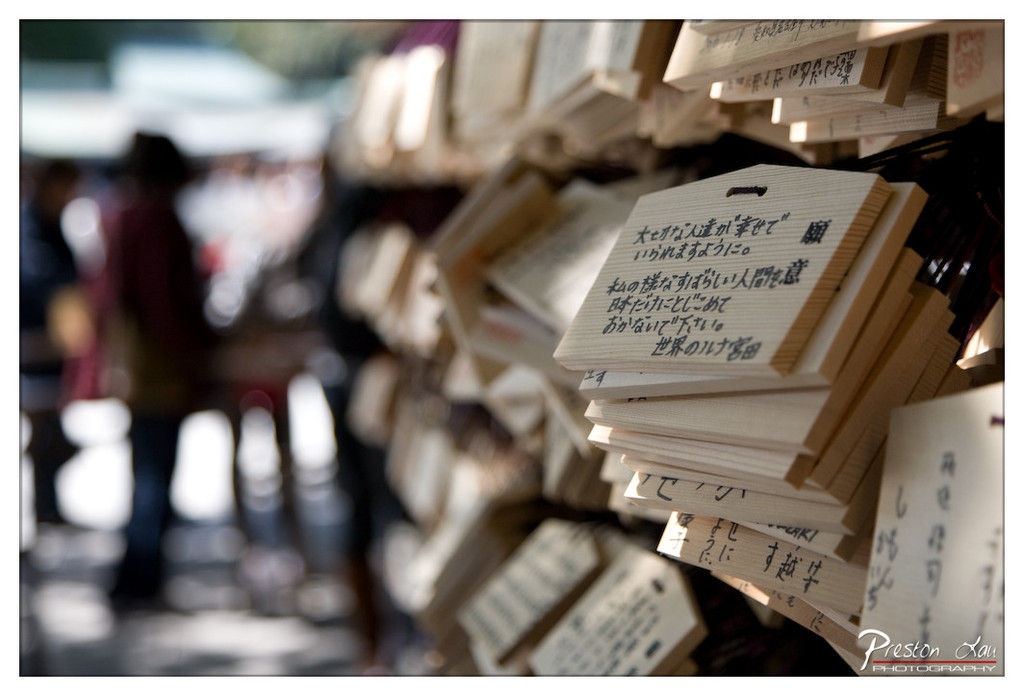

1. Overall Rating (0–10) — 7.0
This photograph captures the quiet reverence of a Japanese shrine, where personal prayers etched in ink become a collective tapestry of hope and longing. The shallow depth of field draws the viewer’s eye to the handwritten messages, creating an intimate connection with the unseen individuals behind each wish. While the image successfully evokes a contemplative mood, the background remains indistinct, slightly diminishing the sense of place and context.
2. Composition (0–10) — 7.5
The diagonal arrangement of the wooden plaques leads the eye through the frame, creating a sense of movement and depth. The blurred figures in the background add subtle human presence without distracting from the primary subject.
3. Lighting (0–10) — 6.5
Natural daylight softly illuminates the foreground, enhancing the texture of the wood and the legibility of the script. However, the shadows are somewhat flat, limiting the dramatic contrast that could elevate the mood.
4. Color & Tone (0–10) — 6.0
The palette is restrained—dominated by natural wood tones and the black of the ink—resulting in a subdued, almost monochromatic feel. While this supports the solemn atmosphere, a touch more warmth or tonal variation could add visual richness.
5. Creativity (0–10) — 7.0
The choice to focus on the personal, handwritten prayers transforms a familiar cultural scene into a deeply human narrative. The selective focus emphasizes the intimacy of individual hopes, making the image more than a mere documentary capture.
6. Technical Quality (0–10) — 7.5
The focus is precisely placed on the central plaque, rendering the handwriting crisp and readable. The background is appropriately blurred, demonstrating effective use of aperture control.
7. Emotional Impact (0–10) — 7.5
The image resonates with quiet introspection, inviting the viewer to consider the weight of the words and the emotions behind them. The combination of text, texture, and soft light creates a poignant, almost sacred atmosphere.
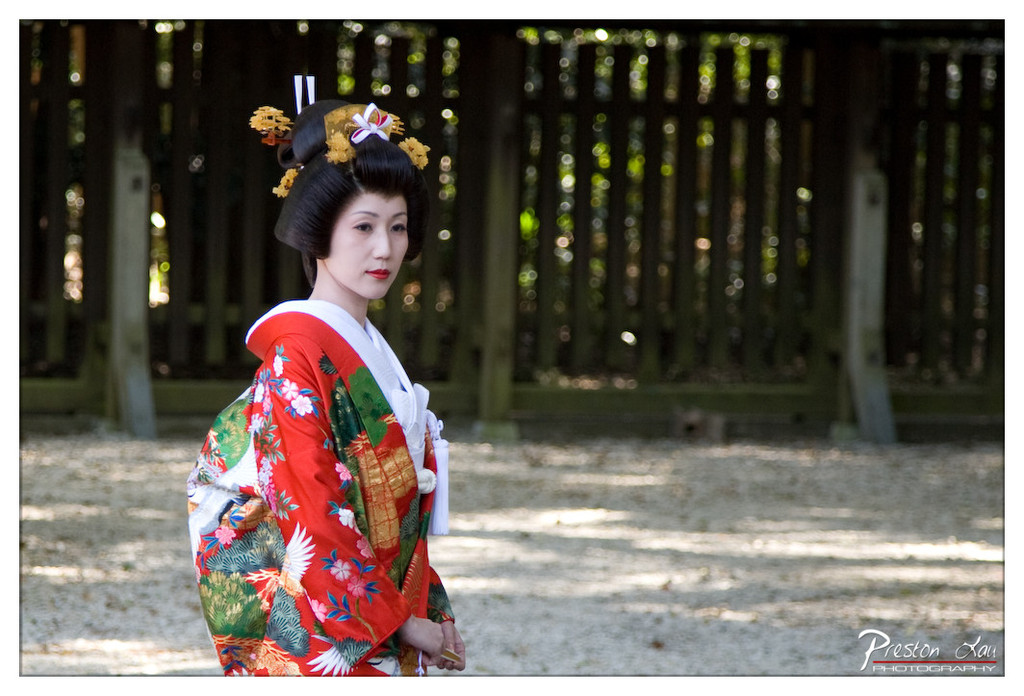

1. Overall Rating (0–10) — 8.0
This photograph captures the elegance and stillness of a geisha in traditional attire, standing poised against a softly blurred wooden fence. The rich colors of the kimono contrast beautifully with the muted, natural background, creating a sense of timelessness and cultural depth. While the image is visually striking, a more deliberate pose or expression might deepen the emotional narrative, but as it stands, it succeeds as a refined portrait of tradition and grace.
2. Composition (0–10) — 8.0
The subject is placed slightly off-center, following the rule of thirds, which draws the eye naturally to her face and attire. The shallow depth of field isolates her from the background, emphasizing her presence while the vertical lines of the fence add subtle structure without distraction.
3. Lighting (0–10) — 7.5
Natural sunlight filters through the trees, creating soft highlights and gentle shadows that enhance the texture of the kimono and the subject’s features. The light appears warm and diffused, contributing to a calm and serene mood.
4. Color & Tone (0–10) — 9.0
The vibrant red of the kimono, paired with the green, white, and gold accents, creates a visually rich and harmonious palette. The warm tones contrast beautifully with the cool, earthy background, enhancing the subject’s prominence and the image’s overall aesthetic appeal.
5. Creativity (0–10) — 8.5
The photographer captures a moment of quiet dignity, blending cultural authenticity with artistic composition. The choice to focus on the geisha’s profile and the use of natural light lend the image a contemplative, almost cinematic quality.
6. Technical Quality (0–10) — 8.0
The image is sharp and well-focused, particularly on the subject’s face and kimono. The depth of field is expertly managed, with a clean bokeh effect that enhances the subject without distracting from the overall composition.
7. Emotional Impact (0–10) — 8.0
The stillness and composed expression evoke a sense of reverence and introspection. The viewer is invited to reflect on the cultural significance and personal dedication behind the geisha’s role, creating a quiet but powerful emotional resonance.
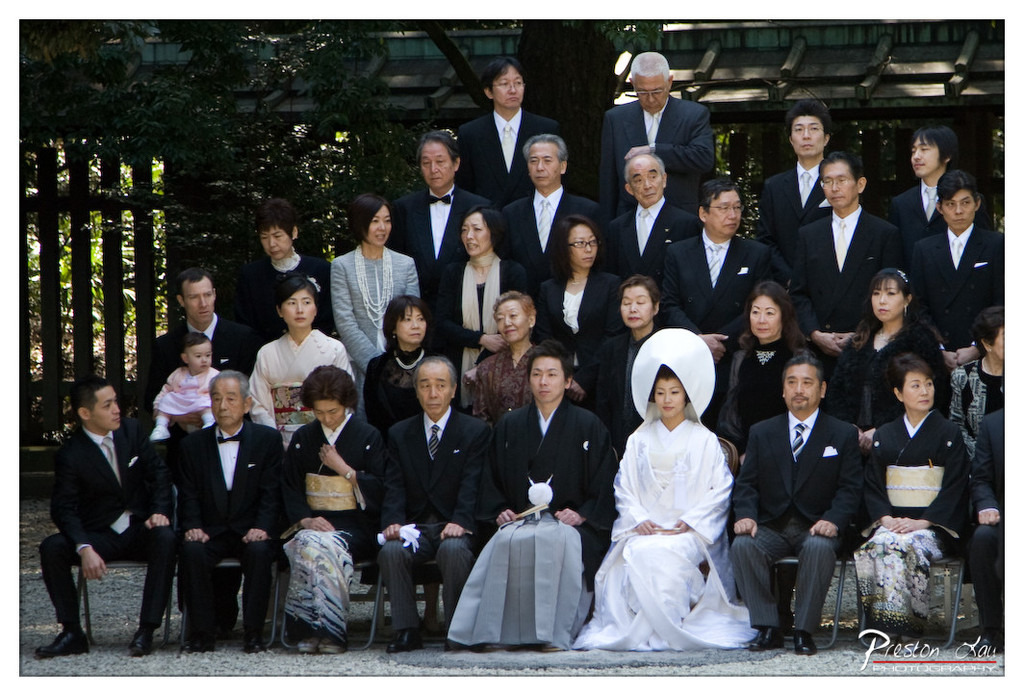

1. Overall Rating (0–10) — 7.5
This photograph captures the solemn elegance of a traditional Japanese wedding, with the bride and groom at the center surrounded by family in formal attire. The composition balances cultural authenticity with a sense of intimate ceremony, while the natural setting grounds the moment in quiet dignity. Though the image feels slightly overexposed in highlights, the emotional weight of the gathering remains powerful and resonant.
2. Composition (0–10) — 8.0
The subjects are arranged in a classic group portrait format, with the bride and groom centrally framed and seated to emphasize their importance. The layered rows create depth, while the symmetry and alignment lend a formal, composed feel. The background foliage adds texture without distracting from the subjects.
3. Lighting (0–10) — 6.5
Natural daylight illuminates the scene evenly, but with a slightly flat quality that softens shadows. The bright white of the bride’s kimono is slightly overexposed, losing some detail in the highlights. Despite this, the lighting supports the serene mood without creating harshness.
4. Color & Tone (0–10) — 7.0
The palette is dominated by deep blacks, crisp whites, and subtle earth tones, reflecting the formality of the occasion. The contrast between the bride’s white kimono and the dark suits enhances visual focus. A slightly cool color cast gives the image a restrained, dignified tone.
5. Creativity (0–10) — 7.5
The image successfully captures a culturally rich moment with authenticity and respect. The inclusion of family members and traditional attire elevates it beyond a mere formal portrait, suggesting a story of heritage and unity. The photographer’s choice to frame the scene in natural light adds a layer of quiet realism.
6. Technical Quality (0–10) — 7.5
The image is sharp and well-focused, with fine detail visible in the textures of the kimonos and suits. The depth of field is appropriate, keeping the main subjects in focus while softly blurring the background. The watermark is subtle and does not detract from the composition.
7. Emotional Impact (0–10) — 8.0
The photograph evokes a sense of reverence and familial connection, with each face contributing to the narrative of a shared milestone. The stillness of the moment and the formal arrangement convey a deep emotional gravity, making the viewer feel like a respectful observer of a significant life event.
Loading map...